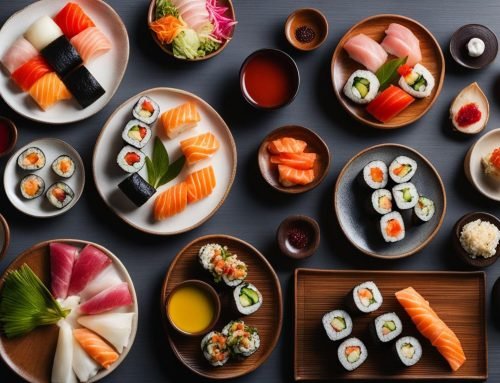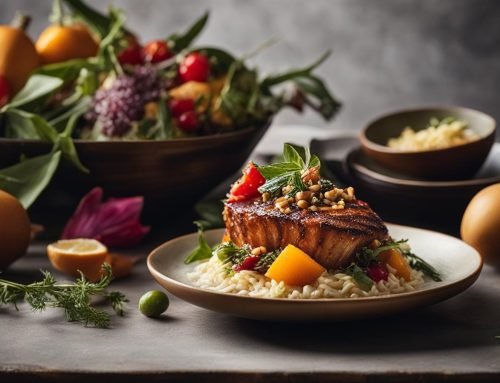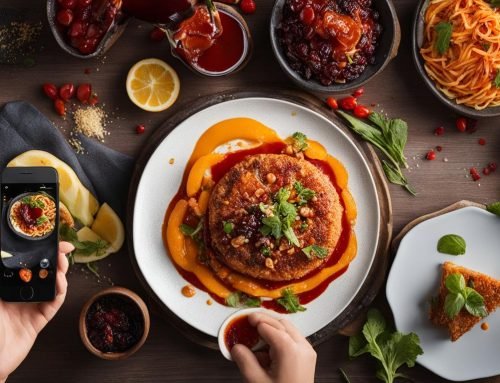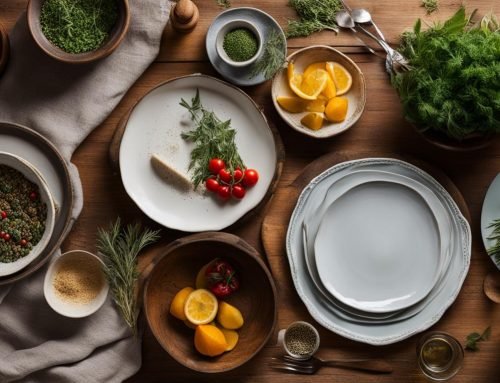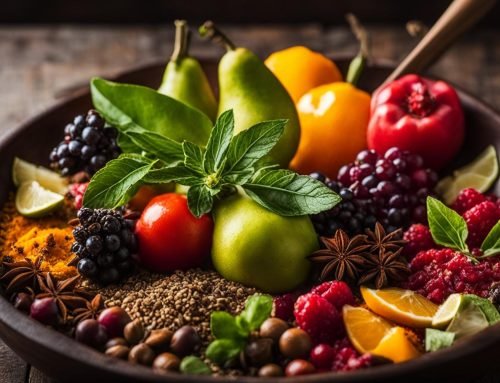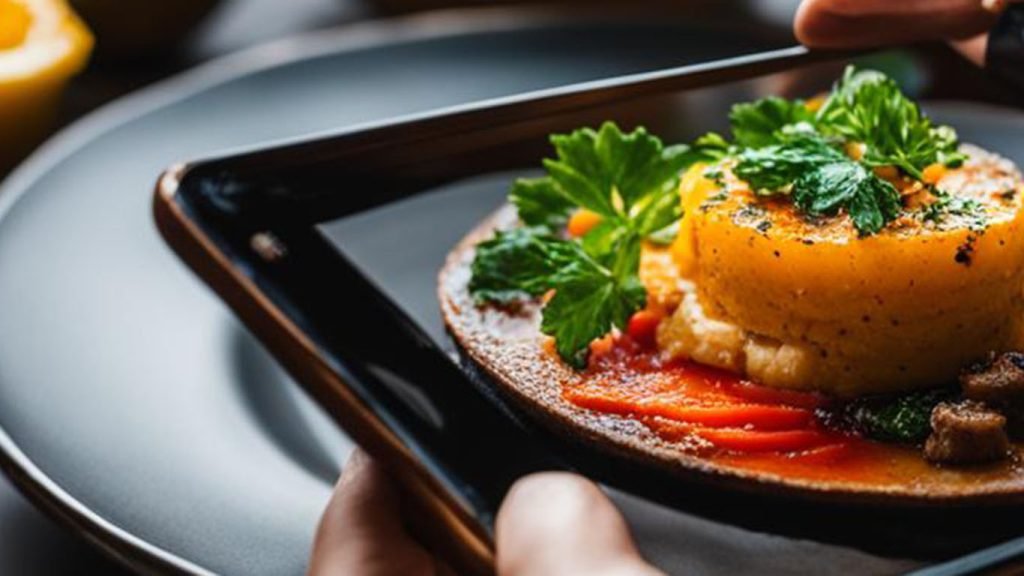
Food photography is a popular and in-demand field that combines photography skills with a passion for food. This guide will provide you with a comprehensive overview of food photography techniques, including tips for composition, lighting, styling, and editing. Whether you’re a beginner or an experienced photographer, these techniques will help you capture stunning images that showcase your culinary adventures.
Key Takeaways:
- Learn essential composition techniques for visually appealing food photography.
- Master different lighting techniques to enhance your food images.
- Discover styling tips to create appetizing and aesthetically pleasing food photographs.
- Invest in the right equipment to achieve professional-looking results.
- Understand the importance of editing and how it can elevate your food photographs.
Tips for Composition in Food Photography
In food photography, composition plays a crucial role in captivating your audience and creating visually appealing images. Here are some essential tips to enhance your food photography composition:
- Utilize the rule of thirds: Imagine your frame divided into nine equal parts using two horizontal and two vertical lines. Place your main subject or point of interest at any of the intersections or along the lines to create a visually pleasing composition.
- Consider color contrast: Pay attention to the colors in your composition and aim for contrast to make your subject stand out. For example, pair a vibrant red strawberry with a contrasting green backdrop to create an eye-catching image.
- Utilize negative space: Embrace empty space around your subject to create a clean and minimalist composition. Negative space can draw attention to the main subject and provide a sense of elegance and simplicity.
- Focusing on details: Zoom in on the intricate details of your dish, such as the texture of a crust or the steam rising from a hot beverage. Capturing these details adds depth and interest to your composition.
Adding H3 if relevant:
“Composition is the foundation of a compelling food photograph. It’s about arranging elements in a way that tells a story and creates a visual impact,” says renowned food photographer Jane Smith. “Experiment with different angles, perspectives, and placements to find the composition that best showcases the character and beauty of the dish.”
By implementing these composition techniques and experimenting with different approaches, you can elevate your food photography and create stunning images that engage your audience and convey the essence of the food.
Lighting Techniques for Food Photography
When it comes to food photography, lighting can make all the difference in capturing the true essence and beauty of the dish. Whether you’re shooting with natural light or artificial lighting, understanding and mastering different lighting techniques can elevate your photographs to the next level. Here are some essential lighting techniques for food photography:
1. Backlighting
Backlighting refers to positioning your light source behind the food, facing towards the camera. This technique creates a beautiful glow around the edges of the subject, highlighting its textures and details. It also adds depth and dimension to the image, making the food visually more appealing.
2. Diffusing Harsh Light
Harsh lighting can cast unflattering shadows and create overly bright areas in your photographs. To soften the light, you can use diffusers like white umbrellas, softboxes, or sheer curtains. These tools help to spread the light evenly and create a soft, diffused glow that enhances the colors and textures of the food.
3. Using Reflectors
Reflectors are great tools for bouncing light back onto your subject and filling in shadows. They can be as simple as white foam boards, aluminum foil, or professional reflector discs. By strategically placing reflectors opposite to the light source, you can control the intensity and direction of the light, creating a well-balanced and evenly lit image.
Experimenting with different lighting techniques is key to finding your own unique style in food photography. Whether you prefer the soft and delicate look of natural light or the controlled precision of artificial lighting, always consider the mood and ambiance you want to convey through your photographs. By understanding and implementing these lighting techniques, you’ll be able to capture mouthwatering images of food that make viewers crave for a taste.
Styling Tips for Food Photography
When it comes to food photography, styling plays a crucial role in capturing enticing images that make viewers crave the dishes. Here are some essential tips to help you elevate your food styling game:
- Use fresh ingredients: Fresh ingredients not only look more appetizing but also add vibrancy and texture to your photographs. Be sure to carefully select and arrange the ingredients to create visually appealing compositions.
- Add garnishes for visual interest: Garnishes such as herbs, sauces, or sprinkles can add pops of color and texture to your food photographs. Experiment with different garnishing techniques to enhance the overall composition.
- Consider the placement of props and utensils: Props and utensils can help set the scene and create context for your food images. Choose props that complement the dish and arrange them strategically to create a visually pleasing arrangement.
- Pay attention to details: In food photography, it’s the small details that make a big difference. Highlight the textures, layers, and intricate details of the dish to make it more visually appealing and enticing.
By implementing these styling tips, you can create stunning and mouthwatering food photographs that capture the essence and beauty of the dishes. Remember to experiment, practice, and develop your own unique style that reflects your culinary adventures.
Essential Equipment for Food Photography
Food photography requires the right equipment to capture stunning images that showcase the beauty of the dish. Whether you’re a beginner or an experienced photographer, having the essential equipment will help you achieve professional-looking results.
1. DSLR Camera or High-Quality Smartphone
A DSLR camera is the preferred choice for food photography due to its versatility and superior image quality. However, if you don’t have access to a DSLR, a high-quality smartphone with a good camera can also produce excellent results. The key is to ensure that your camera or smartphone has manual settings, allowing you to have full control over exposure, focus, and other important settings.
2. Various Lenses for Different Perspectives
Having a selection of lenses is essential for capturing different perspectives and compositions. A macro lens is particularly useful for capturing intricate details and close-up shots of food, while a wide-angle lens can help you capture the entire scene and create a sense of depth. Experimenting with different lenses will give your food photographs a unique and creative look.
3. Tripod for Stability
A tripod is a must-have accessory for food photography, as it provides stability and eliminates the risk of camera shake. This is especially important when shooting in low light conditions or when using slow shutter speeds for long exposure shots. A tripod allows you to achieve sharp and well-focused images, even in challenging shooting situations.
4. Props such as Plates and Utensils
Props play a crucial role in food photography, helping to enhance the visual appeal of the dish and create a storytelling element. Invest in a variety of plates, bowls, cutlery, and serving utensils that complement the style and theme of your food. Consider using props with different textures, colors, and shapes to add interest and depth to your compositions.
5. Editing Software like Adobe Lightroom
Editing is an important step in the food photography process, allowing you to fine-tune the colors, exposure, and overall look of your images. Software like Adobe Lightroom provides powerful editing tools to enhance your photographs and achieve a consistent style. Invest in a reliable editing software that suits your editing needs and learn the basics of post-processing to bring out the best in your food photographs.
By having the right equipment, you’ll be well-equipped to capture mouthwatering images that showcase the beauty and artistry of food. Experiment with different techniques and styles to develop your unique photography approach. Remember, the key is to have fun, be creative, and continuously improve your skills to take your food photography to new heights.
The Importance of Editing in Food Photography
Editing is an essential step in the process of food photography. It allows you to enhance the colors, exposure, and overall look of your images, giving them a polished and professional appearance. Through editing, you can fine-tune various elements such as exposure, white balance, saturation, and sharpness, ensuring that your photographs truly capture the essence of the food.
When it comes to editing food photography, software tools like Adobe Lightroom or Photoshop are widely used and highly effective. These programs provide a range of editing options, allowing you to make precise adjustments and achieve the desired look for your images. You can easily correct any imperfections, enhance details, and create a consistent style across your portfolio.
One of the key benefits of editing is the ability to adjust the colors in your images. This is particularly important in food photography, where vibrant and appetizing colors play a significant role. Through editing, you can enhance the natural colors of the food, making it more visually appealing to viewers. Additionally, editing allows you to control the exposure levels, ensuring that your images are well-balanced and properly lit. By mastering the art of editing, you can elevate the overall quality of your food photographs and make them stand out from the crowd.
Tips for Beginners in Food Photography
If you’re new to the world of food photography, don’t worry! With a few essential tips, you can start capturing beautiful images of delicious dishes in no time. Here are some useful pointers to get you started:
- Practice regularly: Like any skill, food photography requires practice. Take the time to experiment with different compositions, angles, and lighting setups. The more you practice, the better you’ll become at capturing mouthwatering images.
- Study the work of experienced photographers: Look for inspiration from professional food photographers. Study their compositions, lighting techniques, and styling choices. Pay attention to the way they use color, props, and textures to create captivating images.
- Experiment with angles and compositions: Don’t be afraid to try different angles and compositions. Get close to the food to capture its intricate details, or step back for a wider shot that showcases the overall scene. Play around with the rule of thirds and negative space to create visually appealing images.
- Seek feedback from others: Share your work with fellow photographers or online communities and ask for constructive feedback. Learning from others’ perspectives can help you identify areas for improvement and gain fresh ideas for your next shoot.
Remember, patience and persistence are key when starting out in food photography. It takes time to develop your skills and create a unique style. Keep practicing, learning, and refining your techniques, and soon you’ll be capturing stunning images that make mouths water.
Conclusion
Food photography is a dynamic and ever-evolving field, and staying updated on the latest trends is crucial to succeed in this competitive industry. As you continue on your food photography journey, it’s important to embrace the use of natural light, as it can enhance the colors and textures of your dishes. Additionally, minimalistic styling is gaining popularity, allowing the food to take center stage and speak for itself.
Another emerging trend in food photography is the incorporation of storytelling elements. By creating images that evoke emotions and tell a story, you can engage your audience on a deeper level and make your photographs more memorable. Consider capturing the process of cooking, showcasing the ingredients, or telling the story behind the dish.
Remember, mastering food photography takes time and practice. Through regular practice, experimenting with different angles and compositions, and seeking feedback from others, you can continuously improve your skills. Stay curious and open to learning, as the world of food photography is constantly evolving. By staying informed and embracing the latest trends, you can create stunning food photographs that captivate your audience and set yourself apart in this exciting field.
FAQ
What are some essential tips for composition in food photography?
Some essential tips for composition in food photography include using the rule of thirds, considering color contrast, utilizing negative space, and focusing on details.
How does lighting affect food photography?
Lighting plays a crucial role in food photography, as it can enhance the colors, textures, and overall appearance of the dish. Different lighting techniques such as backlighting, diffusing harsh light, and using reflectors can help achieve a soft and flattering lighting setup.
How can I style food to make it look appetizing in photographs?
Some styling tips for food photography include using fresh ingredients, adding garnishes for visual interest, considering prop placement, and paying attention to details such as textures and layers.
What equipment do I need for food photography?
Essential equipment for food photography includes a DSLR camera or high-quality smartphone, various lenses, a tripod for stability, and props such as plates and utensils.
How important is editing in food photography?
Editing is a critical step in food photography as it allows you to fine-tune colors, exposure, and overall image appearance. Software like Adobe Lightroom or Photoshop can be used to adjust various elements and enhance details.
What tips do you have for beginners in food photography?
Some essential tips for beginners in food photography include practicing regularly, studying the work of experienced food photographers, experimenting with different angles and compositions, and seeking feedback from others.
What are some current trends in food photography?
Current trends in food photography include the use of natural light, minimalistic styling, and incorporating storytelling elements into photographs.

